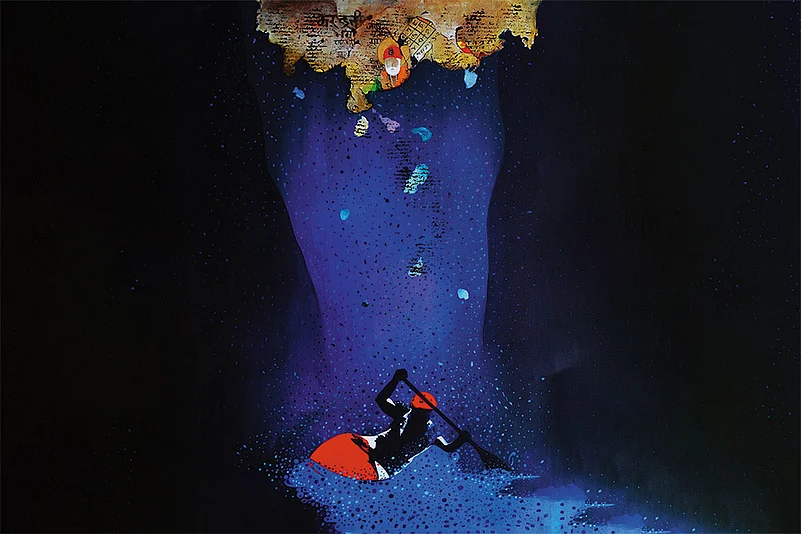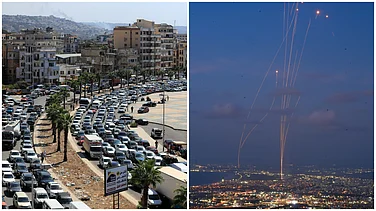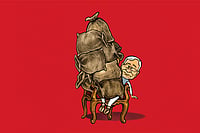This story was published as part of Outlook Magazine's 'Future Tense' issue, dated October 11, 2024. To read more stories from the Issue, click here.
“Srinagar hunches like a wild cat: lonely sentries, wretched in bunkers at the city’s bridges, far from their homes in the plains, licensed to kill . . . while the Jhelum flows under them, sometimes with a dismembered body. On Zero Bridge the jeeps rush by. The candles go out as travellers, unable to light up the velvet Void.
What is the blesséd word? Mandelstam gives no clue. One day the Kashmiris will pronounce that word truly for the first time.”
—Agha Shahid Ali, The Country Without a Post Office
Last time I was in Srinagar in May, a friend asked me to stop suddenly. We were by the Jhelum and he pointed to an epitaph, which was guarded by concertina wires. It was half-hidden by vines and wildflowers that had grown around it. He said, “Take a photo,” before translating the inscription on it, which was in Urdu.
This was the grave of a young man. A very young man who had been killed in a clash. Nobody knew who he was, so they just said that he was a young boy and he was dead now. I have often thought about that one singular grave that doesn’t even make itself visible. Cosmetic changes elsewhere are too in your face. It is a place that’s being renewed again.
That’s how Kashmir comes to someone from the mainland. In fragments. In little corners. In observations.
Elections are being held. The future is tense. Separatists and loyalists and others are all staking their claims to this place that’s sold to all as paradise.
Although never a tourist sold to the idea of this paradise, I was still an outsider who didn’t know how to react to concertina wires and bunkers and security personnel everywhere.
It was disorienting then. It is the same now.
In May, I had gone to see Naya Kashmir, as our Prime Minister had urged the media to see for ourselves, the new version of Kashmir. Elections for the Lok Sabha were underway, and there were a lot of claims of normalcy by the government and many media houses that didn’t really listen to the silence. Roads were widened, tiles were put in, the old Ghanta Ghar at Lal Chowk was renovated and the clocks, that had never shown the right time, were reset to match the Indian Standard Time. Kashmir was to be standardised.
But in this Naya Kashmir, you can still find the scattered remains of the older one. Even Sheikh Abdullah in his time had promised a Naya Kashmir. When it is about Kashmir, one must repeat the fragments so that the story isn’t killed. In May, I met with a man I had known for a few years to ask what was to happen. Local elections would take place after the Lok Sabha polls were done and dusted. He looked at me and then he said that in this place, all kinds of extreme things like violence, loss, and despair were palpable, but nobody really has hope. “There’s fear,” he said. “A strange kind of fear.”
The fear was right there, in the way this man lit one cigarette after another, as if he has to fill the room with this smoke, so he could watch the outside enveloped in this haze. So that nobody from the outside could see him, hear him even. He showed me his work. He had been photographing the unmarked graves. There is a shirt hung on a tree. Through the seasons, the moss, the snow, the rain and the sun have left their scars on the shirt of the person who lies buried. Nobody knows whose body it is. For the gravedigger, he said, it must be sad to be digging so much. As a mark of respect, the gravedigger hung a shirt or anything else that he found on the body as a marker. And then, the trees took these in. A merger happened.
I have written about this before. In repeating this story, I am trying to rid myself of this image. But it stays. There isn’t much otherwise in a place where narratives collide and splinter. There is no one truth. There was silence once and now, there is that cacophony of voices that seem to promise the impossible. Or at least it seems impossible from where I am. Restoration of Article 370 is one of the main issues during these elections. Dignity, regional parties say, must be brought back.
In May, the region, which has seen a lot of changes in the last decade, broke its silence. In election rallies, candidates said they had to break the silence that they had kept for so long after the abrogation of Article 370, making it possible for outsiders to settle in this so-called paradise. But the paradise is a strange myth that has long been perpetuated by the people here and the people outside. We need the promise of a paradise. Heaven is a place and all places can be occupied. Kashmir is a place of anonymous graves and normalised disappearances. There’s the barbed wire that wraps this place, like cellophane tape. It is a place of guns and tear gas.
In this newest Naya Kashmir, there is that repurposing of that old place, which once cried for azadi. Nobody talks about freedom anymore. There’s development instead. The glitter and the sheen. Like snow. They call snow, sheen, here, in Persian.
The seasons have changed too. There is a lot of sunshine now. Like in Delhi.
There is a poem from that famous poet called Agha Shahid Ali called Snowmen.
Once all is refurbished and reconfigured, a poem will stand its ground.
“No, they won’t let me out of winter,
and I’ve promised myself,
even if I’m the last snowman,
that I’ll ride into spring
on their melting shoulders,” Ali wrote in Snowmen.
They say it is the fragmented narratives that snatch away the scraps from history and mock it. Kashmir can never be one story. Not for anyone.
Fragmented narratives are independent and honest. In their brokenness, they reveal that this place can’t be glued back together. From the temporary stages, the candidates whose numbers run into hundreds, proclaim their allegiance to this land that is now Naya again. The artist who saw the shirt and photographed it in all seasons knows that even a piece of fabric can defy time’s onwards march here. Loss defies time. Memory, too.
In May this year, Union Home Minister Amit Shah said that once the elections are over, the government will start the process of restoring statehood to the Union Territory. In May, we broke our silence with Outlook’s cover issue on the imposed silence.
This cover issue, called Future Tense, is about the region’s bid to keep its identity in the face of this silence. Srinagar hunches like a wild cat. This issue ends with a short story called Barzakh by Shabir Ahmad Mir. Fiction is more telling in a post-truth place like Kashmir.
MORE FROM THIS ISSUE
Read it. And then, think of that boy in that grave.
(This appeared in the print as 'Crouching Kashmir')



































